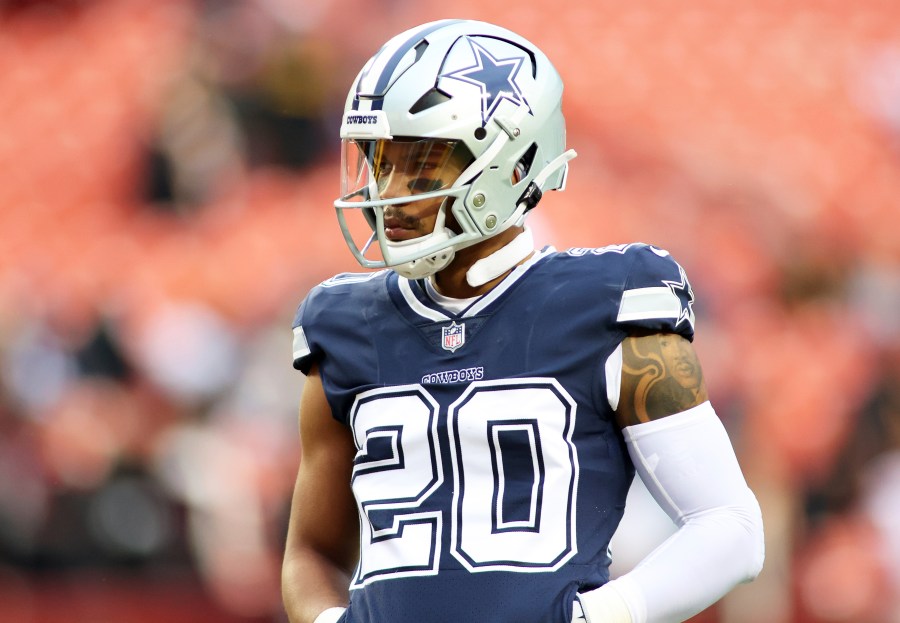What are NFL players wearing on their necks?
(NEXSTAR) – If you’ve been watching any NFL games recently, you might have noticed some players sporting white (or in some cases, black) horseshoe-shaped collars around their necks. But what are they?
First of all, these collars aren’t new. Some players, like former Carolina Panthers linebacker Luke Kuechly, were wearing them as early as 2016. Now, it seems like new players are wearing them every week.
Known as a Q-Collar, the device is intended to protect athletes’ brains during head impacts. The Food and Drug Administration authorized the marketing of Q30 Innovations’ Q-Collars in 2021, saying they “may reduce the occurrence of specific changes in the brain that are associated with brain injury.”

When an athlete – or any person – is hit in the head or body, they may suffer a traumatic brain injury, known as a TBI. A leading cause of TBI is blunt trauma accidents, which are among the most common in sports, according to the National Institute of Neurological Disorders and Stroke.
In a blunt trauma accident, a person’s brain will typically move unrestrained in the skull, the FDA explains. This is often known as a “slosh.”
Is the halftime performer lip-syncing? Here’s how to know
According to the FDA, the Q-Collar compresses against the jugular veins in the athlete’s neck, increasing the volume of blood in their skull’s blood vessels. The increased blood volume then “creates a tighter fit of the brain inside the skull.” That tighter fit can then reduce the “slosh” movement.
It isn’t just NFL players and other athletes that you’ll see wearing Q-Collars. Last fall, the U.S. Army Medical Research and Development Command awarded Q30 Innovations a $2.8 million contract to fund research and development of the Q-Collar to determine if it can reduce blast-induced TBIs among soldiers.
In its 2021 authorization, though, the FDA warned that Q-Collars shouldn’t be used by athletes with certain conditions and can’t prevent concussions or serious head injuries. Even Kuechly suffered a concussion in the weeks after he began wearing the Q-Collar.
You’ll remember these Super Bowl ads if you grew up in the 90s
Adil Hussain, D.O., a physical medicine and rehabilitation doctor who specializes in brain injury medicine at Rancho Los Amigos National Rehabilitation Center in California, told ABC News after the FDA’s authorization that, in theory, the Q-Collar works like a seat belt for the brain.

But Hussain and other experts expressed concerns over athletes overestimating the device’s ability to prevent concussions or more severe brain injuries – something that hasn’t been supported by research.
Which Super Bowl squares are the most valuable?
The FDA expressed its own concerns in October 2022, citing uncertainty about part of the study that led to the Q-Collar’s approval in a summary of its decision, The New York Times reports. The study emphasized the difference in brain tissue changes detected in scans for athletes wearing the collar versus those that weren’t, claiming those that did wear the collar had fewer changes. According to New York Times, the FDA said the link between changes in study participants’ brain tissue and real brain injuries had yet to be “validated.”
Experts speaking with the outlet noted that while the idea of protecting the brain from inside the skull is worthwhile, studies supporting the Q-Collar’s effectiveness aren’t. They pointed to the data in the study as not making sense and that the scans are difficult to interpret, adding that few conclusions could be drawn based on the results. Even Q30 Innovations acknowledges additional research is needed to determine the benefits the collar can provide.
Still, you can expect to see athletes across multiple sports wearing the collars. Q30 lists multiple athletes as its ambassadors on its site, including Dallas Cowboys running back Tony Pollard, Philadelphia Eagles running back Boston Scott, and retired Pro Bowler Vernon Davis.
Copyright 2023 Nexstar Media Inc. All rights reserved. This material may not be published, broadcast, rewritten, or redistributed. Regular the hill posts
Video/Hill.TV










